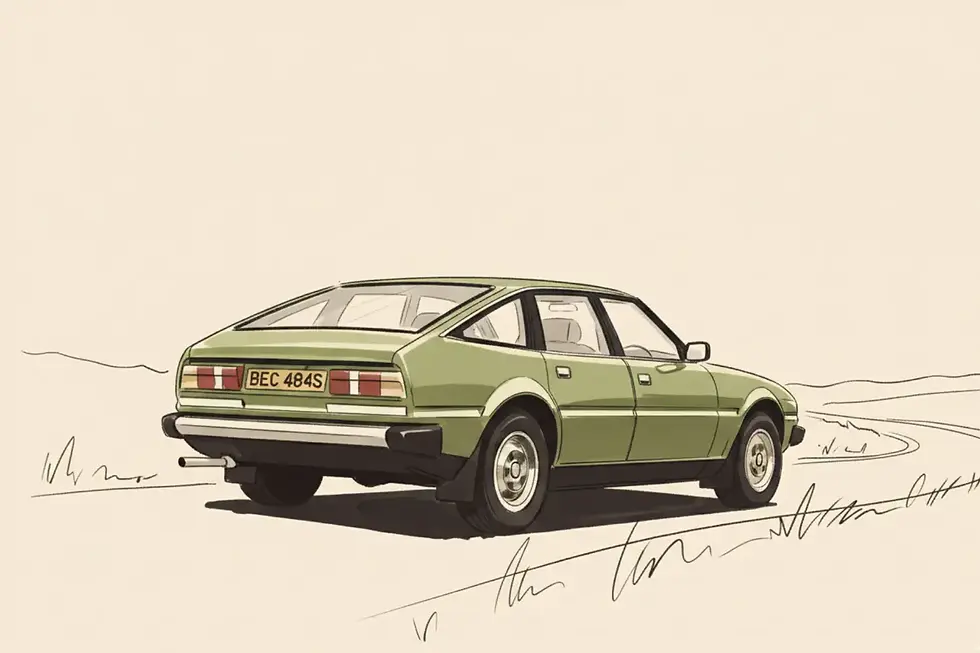Liftback

Liftback /lift-bak/ noun (countable)
A liftback is a car body style, similar to a fastback, that features a single, top-hinged rear door, incorporating the rear window, which provides access to the main passenger and cargo area. This is the clever automotive compromise that offers the swooping, stylish profile of a coupé with the surprising practicality of a hatchback. It is the answer to the fastback's greatest flaw: a long, sloping rear that looked capacious but was betrayed by inadequate access through a tiny, conventional boot lid. It is a wonderfully rational piece of design.
The Full Story of the Liftback
The liftback was born from the desire to have one's cake and eat it too. The traditional saloon was seen as formal and stylish, but its small boot opening made it inadequate for carrying bulky items. The estate car was supremely functional but was often viewed as a utilitarian vehicle for tradesmen. The hatchback, which addressed the access issue, was for a long time seen as a cheap, boxy, and rather continental idea. The liftback was the brilliant solution that blended the best of all worlds.
The concept was arguably pioneered for the mass market by the French with the revolutionary Renault 16 of 1965, a car that combined a saloon-like profile with a substantial "fifth door" at the back. The British motor industry, however, produced some of the most iconic and memorable examples of the breed. The Reliant Scimitar GTE of 1968 created an entirely new genre, the "sporting estate." It was a fibreglass-bodied GT car with a powerful V6 engine, which replaced a conventional boot with an expansive glass hatch, combining sports car performance with genuine usability. It was a favourite of the famously pragmatic Princess Anne.
Perhaps the greatest British champion of the liftback was the Rover SD1 of 1976. This was a large, prestigious executive car, designed to compete with the German saloons from BMW and Mercedes. It had the sleek, aerodynamic profile of a fastback coupé, directly inspired by the Ferrari Daytona. Its masterstroke, however, was its substantial roof-hinged rear door. This gave it a level of versatility that its conventional German rivals could not match, and it was a brilliantly forward-thinking piece of design.
Ford also embraced the layout to great effect. The original Ford Capri was a pure coupé with a small, separate boot. For the Capri MkII in 1974, customer feedback led to a redesign featuring a generous glass hatchback. This single change transformed the car's usability, turning it from a purely style-focused machine into a truly functional everyday car, without sacrificing its sporting image. The term "liftback" has often been tangled up in marketing jargon with "hatchback," "fastback," and "sportback," but the principle remains the same. It is a car that proves style and utility need not be enemies.
For The Record
Is a liftback just a hatchback?
Technically, yes. A liftback is a type of hatchback. The term is generally used to describe a car with a more gently sloped, longer rear hatch, giving it a profile closer to a saloon or fastback. "Hatchback" is often reserved for cars with a more vertical, chopped-off rear end, like a supermini.
What was the first British liftback?
While there were earlier examples of cars with rear hatches, the Reliant Scimitar GTE of 1968 is a strong contender for the first British sporting liftback, establishing the "GTE" or "Grand Touring Estate" concept. The Rover SD1 from 1976 is the most famous large executive liftback.
Why did the Ford Capri switch to a liftback design?
For improved functionality. The original MkI Capri, while stylish, had a conventional small boot that limited its usefulness. For the MkII in 1974, Ford introduced a large rear hatch to make the car more versatile and broaden its appeal to buyers who needed a sporting car that could also handle the realities of daily life.
Does the sloping glass cause any problems?
Yes, it can. The large, sloping rear window can act like a greenhouse, making the car's cabin very hot in the sun. It can also be difficult to see out of, and it collects rain and dirt, which is why most liftbacks are fitted with a rear windscreen wiper, a feature a saloon does not need.
Is the term "Sportback" a liftback?
Yes. "Sportback" is the marketing term used by Audi, and now others, to describe their five-door liftback models, like the A5 and A7 Sportback. It is a more glamorous-sounding name for the same practical design.
